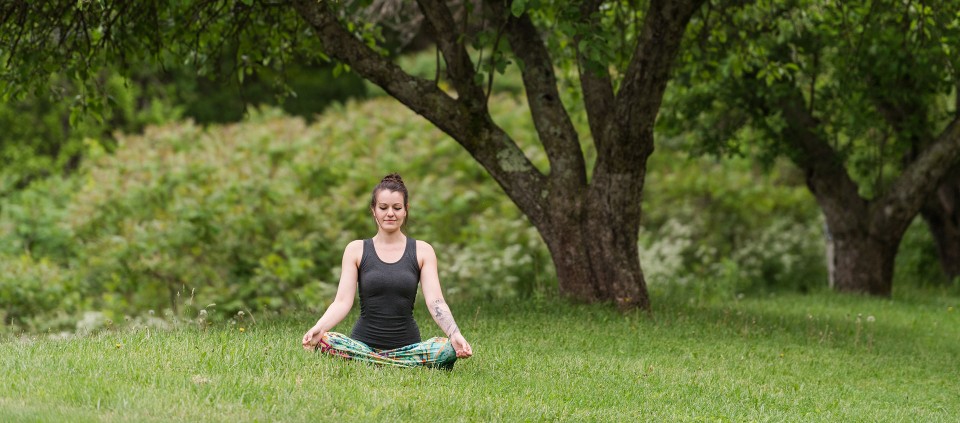Soothing the Anxious Brain with Meditation

If you are like me, you might have what I like to call an overactive “uh-oh center.” This uh-oh center tends to get stirred up when something happens, either externally—we hear some bad news—or internally—when our minds create a story about how bad things are going to be.
From an evolutionary perspective, this uh-oh center cued our ancestors to any dangers that might be coming their way: a deadly snake on the road, a tiger in the brush. But these days, our uh-oh center is fixated less on physically life-threatening situations and more on perceived threats to the self: fewer tigers, more fear of being seen as incompetent.
This uh-oh center has a relatively clear location in the brain—the amygdala, which resides within our limbic system. The amygdala helps us to recognize threats so that we can keep ourselves safe, and it’s key in our stress response system. Like so many things, when we can find the right balance of its activation, it’s helpful; we have to know when danger is present. But when the amygdala is overactive, it can leave us feeling chronically stressed and anxious.
Interestingly, researchers are finding that the amygdala is one of the key places impacted by meditation practice.
Evidence of Meditation’s Ability to Quiet the Mind
In 2010, Sara Lazar, PhD, a key meditation researcher from Massachusetts General Hospital, completed a study on meditation, stress, and amygdala functioning. Prior to this research, she had begun to practice yoga and meditation herself and was intrigued by how it calmed her overanxious mind and reduced her emotional reactivity. As a neuroscientist, she began to wonder if meditation might actually be changing her brain. If yoga and meditation reduced her anxiety and stress, was that an indicator of changes in her amygdala and, if so, would this show up on a brain scan?
To test this hypothesis, she recruited 26 meditation-naïve subjects to participate in her study. Once recruited, participants went through an eight-week mindfulness-based stress-reduction program that included meditation, gentle movement, mindful eating, and also home practices. Would eight weeks be enough to quiet down the uh-oh center?
Sara found that there was an overall trend of decreased perceived stress and a decrease in amygdala activity: the less stressed people reported feeling, the less their amygdala was activated. The amount of training—whether the participants did a lot of home practice or a little—was only mildly correlated with the reduction of stress. Sara’s team cannot say for sure that it was the meditation that produced the change per se—maybe it was the group support, or perhaps people’s outside circumstances changed——o another team of researchers conducted another study, this time including a control group. Was it the mindfulness or was it just the relaxation? The second study, which compared mindfulness meditation to a relaxation training (without a mindful awareness component), had similar results as the first study—amygdala functioning was more modulated in the mindfulness group, suggesting that there was something specifically about mindfulness that helped to reel in an overactive mind.
Meditation’s Impact on Social Anxiety
Another study looking at social anxiety—a condition in which the amygdala is known to be overactive—found that amygdala activity diminished for those who practiced breath meditation, compared to those who just distracted themselves. In this study, 16 participants with social anxiety were placed into a scanner pre- and post-mindfulness intervention. Once in the scanner, they were given phrases meant to trigger their social anxiety, such as “People always judge me,” and were asked either to do nothing or to implement an emotion-regulation strategy, such as breath meditation or counting backward. The participants were then asked to rate how upsetting the phrases were to them.
Results showed significant reductions of social anxiety and improved self-esteem for the group after completion of the mindfulness training. These effects were moderate and similar to other behavioral trainings for social anxiety. The researchers also found that the biggest reduction in reported distress came when participants engaged in the breath meditation, rather than when they tried counting backward. The practice of breath meditation offered these anxious individuals a helpful tool to self-regulate.
Enhancing the Self-Regulation Capacity
In addition, after being trained in breath meditation, the implementation of the tool became automatic. This only happened for the breath meditation group, not the group that was asked to count. With practice, the moment the person saw the phrases meant to elicit anxious feelings, they began to automatically engage the self-regulating breath meditation, without being told to implement the technique; their brains were already self-regulating in response. This suggested that, with practice, the brain can be guided to retrain itself in stressful situations.
Given that participants were more thoroughly trained in breath meditation than in the counting intervention, additional research needs to be done to explore whether or not there is something unique about breath meditation that helps socially anxious people to self-regulate.
Each of these studies point to the possibility of meditation acting as a tool that can help people manage their uh-oh center. While researchers are still exploring how much time in meditation is needed for positive results, both studies suggest that even small amounts of mindfulness training might help people manage stress and anxiety. If you struggle with an overactive uh-oh center, you could try practicing a little mindfulness each day and see if, over time, it helps. Rather than waiting until you are already in the throes of anxiety, practice outside these more intense moments. Like any new skill, mindfulness is a muscle that will grow over time.
Find out about upcoming programs with Angela Wilson on the science of yoga.
© Kripalu Center for Yoga & Health. All rights reserved. To request permission to reprint, please email editor@kripalu.org.
Angela Wilson, LMHC, RYT 500, is a Kripalu faculty member who has conducted research and written about the intersection between yoga, Western psychology, and science.
Full Bio and Programs